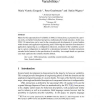Free Online Productivity Tools
i2Speak
i2Symbol
i2OCR
iTex2Img
iWeb2Print
iWeb2Shot
i2Type
iPdf2Split
iPdf2Merge
i2Bopomofo
i2Arabic
i2Style
i2Image
i2PDF
iLatex2Rtf
Sci2ools
ENTCS
2006
2006
Semantics of UML 2.0 Interactions with Variabilities
Means for the representation of variability in UML 2.0 interactions, as presented in a previous work, are further formalised and given a mathematically formal semantics. In this way, UML 2.0 interactions can be used in the conception and development of system families within domain and application engineering tasks. Following the transition from domain to application engineering as a configuration endeavour, resolution of the variability according to a given configuration is captured by a denotational semantics for plain interactions extended to the features for the specification of variability. An example based on a previous case study explicates the semantics hereby defined. Key words: UML interactions, variability, system families, product lines, formal semantics
| Added | 12 Dec 2010 |
| Updated | 12 Dec 2010 |
| Type | Journal |
| Year | 2006 |
| Where | ENTCS |
| Authors | María Victoria Cengarle, Peter Graubmann, Stefan Wagner |
Comments (0)

